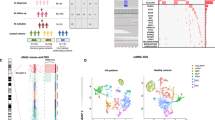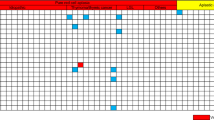Abstract
Fanconi anemia (FA) patients have an increased risk of acute GVHD (aGVHD) after hematopoietic SCT, with hypersensitivity to DNA-cross-linking agents and defective DNA repair. MicroRNA-34 and p53 can induce apoptosis after DNA damage.Here we assessed epithelial cell apoptosis, and studied TP53 and miR-34a expression in the skin and gut biopsies in five non-transplanted FA patients, in 20 FA patients with aGVHD and in 25 acquired aplastic anemia patients (AA). Epithelial apoptosis was higher in FA than in acquired AA patients in both the skin and gut biopsies, though they had a similar preparative regimen. Further study on gut biopsies in FA patients showed that this deleterious effect was not linked to TP53 gene overexpression. As, among p53-independent signaling pathways of apoptosis, the microRNA-34 family mimics p53 apoptotic effects in response to DNA damage, we studied miR-34a expression in the same series of FA patients’ gut biopsies. MiR-34a expression level was higher in severe aGVHD compared with non-aGVHD subjects or non-transplanted patients, and significantly related to apoptotic cell numbers across the three groups of FA patients. Thus, in FA patients, increased apoptosis occurs in target epithelial cells of severe aGVHD, and this deleterious effect is linked to overexpression of miR-34a but not TP53.
This is a preview of subscription content, access via your institution
Access options
Subscribe to this journal
Receive 12 print issues and online access
$259.00 per year
only $21.58 per issue
Buy this article
- Purchase on Springer Link
- Instant access to full article PDF
Prices may be subject to local taxes which are calculated during checkout



Similar content being viewed by others
References
Taniguchi T, D'Andrea AD . Molecular pathogenesis of Fanconi anemia: recent progress. Blood 2006; 107: 4223–4233.
Dufour C, Svahn J . Fanconi anaemia: new strategies. Bone Marrow Transplant 2008; 41 (Suppl 2): S90–S95.
Gluckman E, Auerbach AD, Horowitz MM, Sobocinski KA, Ash RC, Bortin MM et al. Bone marrow transplantation for Fanconi anemia. Blood 1995; 86: 2856–2862.
Gluckman E, Wagner JE . Hematopoietic stem cell transplantation in childhood inherited bone marrow failure syndrome. Bone Marrow Transplant 2008; 41: 127–132.
Guardiola P, Socie G, Li X, Ribaud P, Devergie A, Esperou H et al. Acute graft-versus-host disease in patients with Fanconi anemia or acquired aplastic anemia undergoing bone marrow transplantation from HLA-identical sibling donors: risk factors and influence on outcome. Blood 2004; 103: 73–77.
Moldovan GL, D'Andrea AD . How the fanconi anemia pathway guards the genome. Annu Rev Genet 2009; 43: 223–249.
Freie B, Li X, Ciccone SL, Nawa K, Cooper S, Vogelweid C et al. Fanconi anemia type C and p53 cooperate in apoptosis and tumorigenesis. Blood 2003; 102: 4146–4152.
Kruyt FA, Dijkmans LM, van den Berg TK, Joenje H . Fanconi anemia genes act to suppress a cross-linker-inducible p53-independent apoptosis pathway in lymphoblastoid cell lines. Blood 1996; 87: 938–948.
Garofalo M, Condorelli GL, Croce CM, Condorelli G . MicroRNAs as regulators of death receptors signaling. Cell Death Differ 2009; 17: 200–208.
He L, He X, Lowe SW, Hannon GJ . microRNAs join the p53 network--another piece in the tumour-suppression puzzle. Nat Rev Cancer 2007; 7: 819–822.
Chang TC, Wentzel EA, Kent OA, Ramachandran K, Mullendore M, Lee KH et al. Transactivation of miR-34a by p53 broadly influences gene expression and promotes apoptosis. Mol Cell 2007; 26: 745–752.
Ades L, Mary JY, Robin M, Ferry C, Porcher R, Esperou H et al. Long-term outcome after bone marrow transplantation for severe aplastic anemia. Blood 2004; 103: 2490–2497.
Przepiorka D, Weisdorf D, Martin P, Klingemann HG, Beatty P, Hows J et al. 1994 Consensus Conference on Acute GVHD Grading. Bone Marrow Transplant 1995; 15: 825–828.
Sale GE, Shulman HM, McDonald GB, Thomas ED . Gastrointestinal graft-versus-host disease in man. A clinicopathologic study of the rectal biopsy. Am J Surg Pathol 1979; 3: 291–299.
Epstein RJ, McDonald GB, Sale GE, Shulman HM, Thomas ED . The diagnostic accuracy of the rectal biopsy in acute graft-versus-host disease: a prospective study of thirteen patients. Gastroenterology 1980; 78: 764–771.
Asslaber D, Pinon JD, Seyfried I, Desch P, Stocher M, Tinhofer I et al. microRNA-34a expression correlates with MDM2 SNP309 polymorphism and treatment-free survival in chronic lymphocytic leukemia. Blood 2010; 115: 4191–4197.
Martinez A, Hinz JM, Gomez L, Molina B, Acuna H, Jones IM et al. Differential expression of TP53 associated genes in Fanconi anemia cells after mitomycin C and hydroxyurea treatment. Mutat Res 2008; 656: 1–7.
Barnett GC, West CM, Dunning AM, Elliott RM, Coles CE, Pharoah PD et al. Normal tissue reactions to radiotherapy: towards tailoring treatment dose by genotype. Nat Rev Cancer 2009; 9: 134–142.
de Saint Basile G, Menasche G, Fischer A . Molecular mechanisms of biogenesis and exocytosis of cytotoxic granules. Nat Rev Immunol 2010; 10: 568–579.
Haneline LS, Broxmeyer HE, Cooper S, Hangoc G, Carreau M, Buchwald M et al. Multiple inhibitory cytokines induce deregulated progenitor growth and apoptosis in hematopoietic cells from Fac−/− mice. Blood 1998; 91: 4092–4098.
Rathbun RK, Christianson TA, Faulkner GR, Jones G, Keeble W, O'Dwyer M et al. Interferon-gamma-induced apoptotic responses of Fanconi anemia group C hematopoietic progenitor cells involve caspase 8-dependent activation of caspase 3 family members. Blood 2000; 96: 4204–4211.
Socie G, Blazar BR . Acute graft-versus-host disease: from the bench to the bedside. Blood 2009; 114: 4327–4336.
Janin A, Deschaumes C, Daneshpouy M, Estaquier J, Micic-Polianski J, Rajagopalan-Levasseur P et al. CD95 engagement induces disseminated endothelial cell apoptosis in vivo: immunopathologic implications. Blood 2002; 99: 2940–2947.
Welch C, Chen Y, Stallings RL . MicroRNA-34a functions as a potential tumor suppressor by inducing apoptosis in neuroblastoma cells. Oncogene 2007; 26: 5017–5022.
Raver-Shapira N, Marciano E, Meiri E, Spector Y, Rosenfeld N, Moskovits N et al. Transcriptional activation of miR-34a contributes to p53-mediated apoptosis. Mol Cell 2007; 26: 731–743.
Lyakhovich A, Surralles J . Constitutive activation of caspase-3 and Poly ADP ribose polymerase cleavage in fanconi anemia cells. Mol Cancer Res 2010; 8: 46–56.
Acknowledgements
We thank Mrs Angela Swaine Verdier who reviewed the English language of the manuscript. This work was supported by the University Paris Diderot, Inserm, ANR, InCa. Li Wang was supported by Inserm with an International ‘Poste vert’.
Author information
Authors and Affiliations
Corresponding author
Ethics declarations
Competing interests
The authors declare no conflict of interest.
Additional information
Supplementary Information accompanies the paper on Bone Marrow Transplantation website
Supplementary information
Rights and permissions
About this article
Cite this article
Wang, L., Romero, M., Ratajczak, P. et al. Increased apoptosis is linked to severe acute GVHD in patients with Fanconi anemia. Bone Marrow Transplant 48, 849–853 (2013). https://doi.org/10.1038/bmt.2012.237
Received:
Revised:
Accepted:
Published:
Issue Date:
DOI: https://doi.org/10.1038/bmt.2012.237
Keywords
This article is cited by
-
Circulating miR-455-3p, miR-5787, and miR-548a-3p as potential noninvasive biomarkers in the diagnosis of acute graft-versus-host disease: a validation study
Annals of Hematology (2021)
-
MicroRNAs as biomarkers for graft-versus-host disease following allogeneic stem cell transplantation
Annals of Hematology (2015)
-
Plasma microRNA-586 is a new biomarker for acute graft-versus-host disease
Annals of Hematology (2015)



